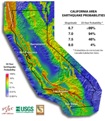
Scientists Predict Massive Quake on California's Horizon
California has a 99.7 percent chance of having a magnitude 6.7 or larger eqarthquake during the next 30 years, a multidisciplinary group of scientists and engineers said today. The likelihood of an even more powerful quake of magnitude 7.5 or greater within the next three decades is 46 percent, and such a quake is more likely to occur in the southern half of the state (37 percent chance) than in the northern half (15 percent chance), the group predicted.
The three-year study leading to the predictions was organized by the Southern California Earthquake Center, the U.S. Geological Survey, and the California Geological Survey, and it received major support from the California Earthquake Authority, which is responsible for setting earthquake insurance rates statewide. The scientists and engineers participating in the study, which they called the Uniform California Earthquake Rupture Forecast (UCERF), said it was the first comprehensive framework for comparing earthquake likelihoods throughout the whole state. The final forecast is a sophisticated integration of scientific data and expert opinion, they said.
According to the new forecast, the probability of a magnitude 6.7 or larger earthquake over the next 30 years striking the greater Los Angeles area is 67 percent, and in the San Francisco Bay area it is 63 percent. The southern San Andreas is the fault line with the highest probability (59 percent) of generating at least one magnitude 6.7 quake or larger during that timeframe. For northern California, the most likely source of such earthquakes is the Hayward-Rodgers Creek Fault (31 percent in the next 30 years). Events of this size can be deadly, as shown by the 1989 Loma Prieta earthquake (magnitude 6.9) and 1994 Northridge earthquake (magnitude 6.7), the group noted.
The group, which calls itself WGCEP 2007, or the 2007 Working Group on California Earthquake Probabilities, also notes that while residents of the state know they live in earthquake country, accurate forecasts of the likelihood of earthquakes can help them prepare for the inevitable events. Because scientists cannot yet make precise predictions of the date, time, and place of future quakes, forecasts must be in the form of the probabilities of quakes of certain sizes occurring during specified periods of time, the group said. For more information covered in today's press conference from Los Angeles, visit www.scec.org/ucerf.